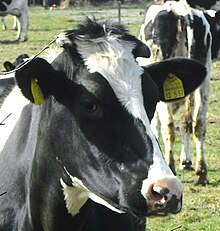German black and white lowland cattle
The Black Pied Lowland cattle , also known as German Black Pied Cattle old Zuchtrichtung called, is a domestic cattle - breed . In Germany it has been called the German Black and White Low Cattle (DSN) since 2006 according to the decision of the breeders' associations . The ID 10 is assigned to her in the breed key .
The breed comes from the coastal areas of northern Germany and the Netherlands . The Black Holstein cattle are smaller than the Holstein cattle that dominate in Germany and have a lower milk yield. However, it is more frugal and has a better fattening performance and is therefore considered a dual-purpose cattle .
Breeding history
Cattle of various colors were bred on the North and Baltic Sea coasts until the 18th century. It was not until after 1750 that the black and white color scheme prevailed. In 1878, then in East Friesland , the first breeding association founded for the Black Pied Lowland cattle, in the following period were East Friesland and East Prussia , the main breeding areas. The breed spread across northern and central Germany.
Since 1958, Holstein cattle have been crossed into the breed for the first time in the Federal Republic of Germany . Since the 1960s, these crossings were able to prevail and the German Holstein cattle emerged.
In the GDR , the black and white dairy cattle (SMR) were bred from the black and white lowland cattle with the help of the Jersey cattle and the Holstein cattle . The original breeding direction of the black and white lowland cattle was preserved in the GDR as a gene reserve . Individual breeders in the Federal Republic of Germany and breeders in the Netherlands were also able to receive the original type of cattle. In 2016 it is in level III (= endangered) on the Red List of Endangered Livestock Breeds of the Society for the Conservation of Old and Endangered Domestic Animal Breeds (GEH) and was declared "Endangered Livestock Breed of the Year" 2016 together with the original Brown Swiss and Glan cattle .
In South America, the Dutch-Argentine cattle emerged from the Holstein breed .
Characteristics / breeding goals
Black Holstein cattle have a height at the withers of 150 to 162 cm (bulls) or 130 to 140 cm (cows) and a weight of 1000 to 1150 kg (bulls) or 550 to 650 kg (cows). They are horned and the cows produce around 7000 kg of milk per year.
Inventory development
In 2013 there were 8 bulls and 2,722 cows in Germany. Earlier surveys showed herds of around 2,200 in 1997 and a decrease to just under 2,000 in 2006. Thereafter, the numbers rose to 2,847 (f) / 71 (m) animals by 2016, before falling again to 2,550 or 19 breeding animals in 2018 .
Web links
Individual evidence
- ↑ Appendix 6 to the Cattle Traffic Ordinance
- ↑ GEH red list , accessed on April 6, 2018
- ↑ a b Breed description on the website of the Society for the Preservation of Old and Endangered Pet Breeds (GEH) , accessed on November 16, 2016
- ↑ Federal Agency for Agriculture and Food : Central Documentation of Animal Genetic Resources in Germany ( TRGDEU ), with slightly different data on mass and height
- ↑ BLE: TRGDEU , with a list of breeding associations

